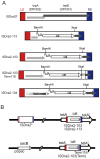Irradiation-induced Deinococcus radiodurans genome fragmentation triggers transposition of a single resident insertion sequence
- PMID: 20090938
- PMCID: PMC2806898
- DOI: 10.1371/journal.pgen.1000799
Irradiation-induced Deinococcus radiodurans genome fragmentation triggers transposition of a single resident insertion sequence
Abstract
Stress-induced transposition is an attractive notion since it is potentially important in creating diversity to facilitate adaptation of the host to severe environmental conditions. One common major stress is radiation-induced DNA damage. Deinococcus radiodurans has an exceptional ability to withstand the lethal effects of DNA-damaging agents (ionizing radiation, UV light, and desiccation). High radiation levels result in genome fragmentation and reassembly in a process which generates significant amounts of single-stranded DNA. This capacity of D. radiodurans to withstand irradiation raises important questions concerning its response to radiation-induced mutagenic lesions. A recent study analyzed the mutational profile in the thyA gene following irradiation. The majority of thyA mutants resulted from transposition of one particular Insertion Sequence (IS), ISDra2, of the many different ISs in the D. radiodurans genome. ISDra2 is a member of a newly recognised class of ISs, the IS200/IS605 family of insertion sequences.
Conflict of interest statement
The authors have declared that no competing interests exist.
Figures



Similar articles
-
ISDra2 transposition in Deinococcus radiodurans is downregulated by TnpB.Mol Microbiol. 2013 Apr;88(2):443-55. doi: 10.1111/mmi.12194. Epub 2013 Mar 15. Mol Microbiol. 2013. PMID: 23461641
-
Mutagenesis via IS transposition in Deinococcus radiodurans.Mol Microbiol. 2006 Jan;59(1):317-25. doi: 10.1111/j.1365-2958.2005.04936.x. Mol Microbiol. 2006. PMID: 16359337
-
Transposition of insertion sequences by dielectric barrier discharge plasma and gamma irradiation in the radiation-resistant bacterium Deinococcus geothermalis.J Microbiol Methods. 2022 May;196:106473. doi: 10.1016/j.mimet.2022.106473. Epub 2022 Apr 22. J Microbiol Methods. 2022. PMID: 35469976
-
The IS200/IS605 Family and "Peel and Paste" Single-strand Transposition Mechanism.Microbiol Spectr. 2015 Aug;3(4). doi: 10.1128/microbiolspec.MDNA3-0039-2014. Microbiol Spectr. 2015. PMID: 26350330 Review.
-
Deinococcus radiodurans: what belongs to the survival kit?Crit Rev Biochem Mol Biol. 2008 May-Jun;43(3):221-38. doi: 10.1080/10409230802122274. Crit Rev Biochem Mol Biol. 2008. PMID: 18568848 Review.
Cited by
-
Contact-free cold atmospheric plasma treatment of Deinococcus radiodurans.J Ind Microbiol Biotechnol. 2012 Sep;39(9):1367-75. doi: 10.1007/s10295-012-1137-6. Epub 2012 May 15. J Ind Microbiol Biotechnol. 2012. PMID: 22584820
-
Ecophysiological and genomic analyses of a representative isolate of highly abundant Bacillus cereus strains in contaminated subsurface sediments.Environ Microbiol. 2022 Nov;24(11):5546-5560. doi: 10.1111/1462-2920.16173. Epub 2022 Sep 1. Environ Microbiol. 2022. PMID: 36053980 Free PMC article.
-
Sense overlapping transcripts in IS1341-type transposase genes are functional non-coding RNAs in archaea.RNA Biol. 2015;12(5):490-500. doi: 10.1080/15476286.2015.1019998. RNA Biol. 2015. PMID: 25806405 Free PMC article.
-
Physiology of Highly Radioresistant Escherichia coli After Experimental Evolution for 100 Cycles of Selection.Front Microbiol. 2020 Sep 22;11:582590. doi: 10.3389/fmicb.2020.582590. eCollection 2020. Front Microbiol. 2020. PMID: 33072055 Free PMC article.
-
Genome Plasticity by Insertion Sequences Learned From a Case of Radiation-Resistant Bacterium Deinococcus geothermalis.Bioinform Biol Insights. 2021 Aug 4;15:11779322211037437. doi: 10.1177/11779322211037437. eCollection 2021. Bioinform Biol Insights. 2021. PMID: 34413635 Free PMC article.
References
-
- Criswell T, Leskov K, Miyamoto S, Luo G, Boothman DA. Transcription factors activated in mammalian cells after clinically relevant doses of ionizing radiation. Oncogene. 2003;22(37):5813–5827. - PubMed
-
- Fu Y, Pastushok L, Xiao W. DNA damage-induced gene expression in Saccharomyces cerevisiae. FEMS Microbiol Rev. 2008;32(6):908–926. - PubMed
-
- Zhou BB, Elledge SJ. The DNA damage response: putting checkpoints in perspective. Nature. 2000;408(6811):433–439. - PubMed
Publication types
MeSH terms
Substances
LinkOut - more resources
Full Text Sources
Other Literature Sources
Molecular Biology Databases

